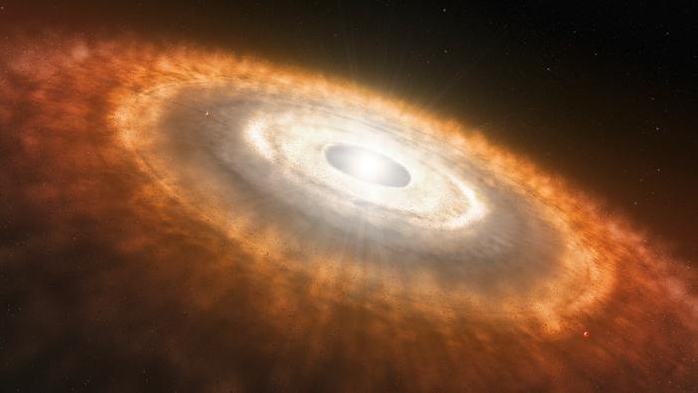A study of one of the most extreme, radiation-heavy environments in the universe has found that it might be possible for rocky planets comprised of water, carbon and other familiar molecules to form under far more intense circumstances than previously believed.
It’s the first piece of data to come out of the eXtreme Ultraviolet Environments (XUE) study, which uses data from the James Webb Space Telescope to investigate the enormous spinning disc of gas, dust and rocks where planets eventually form around one or more central stars.
Studying these planet-forming discs before any planetary systems have emerged from them allows scientists to get an idea of how their environments factor into the formation of planets.
Around 5,500 light years away from Earth, in the constellation of Scorpius, there’s a nebula called the Lobster Nebula which is home to some of most massive stars in our galaxy and some of the most dramatic planet-forming circumstances. Fifteen planet-forming discs inside this nebula are what XUE is focused on.
Their first results, described in a paper published Thursday in The Astrophysical Journal, centre on a specific protoplanetary disc, called XUE 1, which is located in the star cluster Pismis 24.
This disc rotates near several enormous stars, and should be bombarded with the kind of ultraviolet radiation that would make it difficult for a stable environment to form.
However, astronomers have detected some of the molecules that are found on our own rocky planet of Earth, including water and carbon dioxide.
“We find that the inner disk around XUE 1 is remarkably similar to those in nearby star-forming regions,” Rens Waters, one of the authors from Radboud University in the Netherlands, said in a press release. “We’ve detected water and other molecules like carbon monoxide, carbon dioxide, hydrogen cyanide, and acetylene. However, the emission found was weaker than some models predicted. This might imply a small outer disk radius.”
It’s data that astronomers haven’t been able to gather before. This type of research is only made possible through the Medium Resolution Spectrometer on James Webb’s Mid-Infrared Instrument (MIRI), according to the release.
“Webb is the only telescope with the spatial resolution and sensitivity to study planet-forming disks in massive star-forming regions,” María Claudia Ramírez-Tannus, of the Max Planck Institute for Astronomy in Germany.
Lars Cuijpers, another team member with Radboud University, added in the release that the team were “surprised and excited” by what they’d discovered so far.
“This is the first time that these molecules have been detected under these extreme conditions.”
Researchers also detected the presence of a silicate dust on the surface of the disc, which is one of the clear building blocks of rocky planets.
Previously, the majority of research on planet-forming discs had centred on a few specific, well-studied discs, largely near low-mass stars. However, since the majority of stars and planetary systems are believed to form within massive star-forming regions such as the Lobster Nebula, our current understanding of how planets form could be skewed by our lack of data on these regions.
This new research is a first step into filling that gap of knowledge, researchers say.
We now have data on protoplanetary discs in these more high-stress environments which aligns with existing data on well-studied protoplanetary discs in calmer regions of the universe. This means that rocky planets may be able to form near high-mass stars and not just near low-mass stars like our Sun, and that rocky planets may be able to survive in a broader range of environments.
“XUE 1 shows us that the conditions to form rocky planets are there, so the next step is to check how common that is,” Ramírez-Tannus. “We will observe other disks in the same region to determine the frequency with which these conditions can be observed.”




